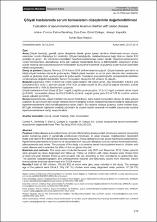| dc.contributor.author | Comba, Atakan | |
| dc.contributor.author | Demirbaş, Fatma | |
| dc.contributor.author | Eren, Esra | |
| dc.contributor.author | Çaltepe, Gönül | |
| dc.contributor.author | Kayadibi, Hüseyin | |
| dc.contributor.author | Kalaycı, Ayhan Gazi | |
| dc.date.accessioned | 2021-11-01T18:17:54Z | |
| dc.date.available | 2021-11-01T18:17:54Z | |
| dc.date.issued | 2018 | |
| dc.identifier.citation | Comba, A., Demirbaş, F., Esra, E. R. E. N., Çaltepe, G., Kayadibi, H., & Kalaycı, A. G. (2018). Çölyak hastalarında serum homosistein düzeylerinin değerlendirilmesi. Pamukkale Tıp Dergisi, 11(3), 215-222. | en_US |
| dc.identifier.issn | 1309-9833 | |
| dc.identifier.issn | 1308-0865 | |
| dc.identifier.uri | https://doi.org10.31362/patd.402656 | |
| dc.identifier.uri | https://app.trdizin.gov.tr/makale/TXpJMU5EazRPQT09 | |
| dc.identifier.uri | https://hdl.handle.net/11491/7761 | |
| dc.description.abstract | Amaç:Çölyak hastalığı, genetik yatkın bireylerde diyetle gluten içeren tahılların tüketilmesi sonucu oluşan otoimmün, kronik inflamatuar bir hastalıktır. Çölyak hastalığında, malabsorbsiyona bağlı folat ve vitamin B12 eksikliği sık gelişir. Bu vitaminlerin eksiklikleri hiperhomosisteinemiye neden olabilir. Hiperhomosisteineminin venöz tromboemboli, ateroskleroz, inme gibi vasküler hastalıklarla ilişkisi iyi bilinmektedir. Çalışmanın amacı çölyak hastalığı olan çocuklarda serum homosistein düzeylerini incelemek ve glutensiz diyetin bunun üzerindeki etkisini araştırmaktır. Gereç ve yöntem:Çalışma, Temmuz 2013-Kasım 2016 tarihleri arasında yapıldı. Çölyak hastaları yeni tanılı ve takipli çölyak hastaları olarak iki gruba ayrıldı. Takipli çölyak hastaları en az bir yıldır izlemde olan hastalardan seçildi ve glutensiz diyet uyumuna göre iki gruba ayrıldı. Hastaların sosyodemografik, antropometrik özellikleri ve laboratuvar değerleri kaydedildi. Serum homosistein düzeyi ELISA yöntemi ile çalışıldı. Bulgular:Çalışmaya 106’sı (%63.9) kız olmak üzere toplam 166 çocuk alındı. Yaş ortalamaları 9.6±4.9 yıldı Çocukların 50’si (%30.1) yeni tanı çölyak, 57’si (%34.3) takipli çölyak ve 59’u (%35.5) sağlıklı kontroldü. Çölyak hastalarının 69’u (%64.5) diyetine tam uyuyordu. Çölyak hastalarının folat düzeyi (8.9±4.1 mg/dL) sağlıklı çocuklara göre (10.3±3.2 mg/dL) anlamlı olarak düşük (p=0.042), homosistein düzeyi de 8.9 (2.8-49.5) nmol/mL; sağlıklı gruba göre 8.2 (4.7-25.8) nmol/mL anlamlı olarak yüksekti (p=0.032). Sonuç:Çalışmamızda, çölyak hastalarında serum folat düzeyi daha düşük homosistein düzeyi de daha yüksek saptandı. Bu durum yeni tanı çölyak hastalarında en belirgindi. Çölyak hastalarında folat eksikliğine bağlı görülen hiperhomosisteinemi ciddi komplikasyonlara neden olabilir. Bu nedenle hastalar glutensiz diyete ilaveten folat, B12 gibi mikrobesin öğelerinin eksikliği yönünden de düzenli olarak taranmalı ve eksiklik durumunda mutlaka hiperhomosisteinemi varlığı araştırılmalıdır | en_US |
| dc.description.abstract | Purpose: Celiac disease is an autoimmune, chronic inflammatory disease which occurs as a result of consuming gluten containing grains in genetically predisposed individuals. In celiac disease, malabsorption dependent folate and vitamin B12 deficiencies develop frequently. These deficiencies can cause hyperhomocysteinaemia. Hyperhomocysteinaemia is known to be associated with vascular diseases such as venous thromboembolism, atherosclerosis and stroke. The purpose of the study is to analyze serum homocysteine levels in children with celiac disease and to examine the effect of this on gluten-free diet. Materials and methods: The study was conducted between July 2013 and November 2016. Celiac patients were grouped as newly diagnosed and follow-up. Follow up children with celiac disease were chosen from at least one-year disease follow-up and grouped into two according to their compliance to gluten-free diet. The patients’ sociodemographic and anthropometric features and laboratory values were recorded. Serum homocysteine level was determined with ELISA method. Results:A total of 166 children, 106 (63.9%) of whom were girls, were included in the study. The average age of the patients were 9,6±4,9. Fifty (30.1%) children were newly diagnosed celiac patients, 57 (34.3%) were follow-up celiac patients and 59 (35.5%) were healthy controls. Folate level of celiac patients (8.9± 4.1 mg/dL) was found to be significantly lower and homocysteine level (8.9 (2.8-49.5) nmol/mL) was found to be significantly higher when compared with healthy children (10.3±3.2 mg/dL, 8.2 (4.7-25.8) nmol/mL, respectively) (p=0.042=0.032). Conclusion:In our study, celiac patients were found to have lower folate level and higher homocysteine level. This situation was the distinct detail in newly diagnosed patients. In celiac patients, hyperhomocysteinaemia as a result of folate deficiency can cause serious complications. Thus, the celiac patients should be screened regularly in terms of the deficiency of micro food elements and in case of deficiency, hyperhomocysteinaemia presence should be researched. | en_US |
| dc.language.iso | tur | en_US |
| dc.relation.ispartof | Pamukkale Tıp Dergisi | en_US |
| dc.rights | info:eu-repo/semantics/openAccess | en_US |
| dc.subject | Gastroenteroloji ve Hepatoloji | en_US |
| dc.subject | Hematoloji | en_US |
| dc.subject | Rehabilitasyon | en_US |
| dc.subject | Romatoloji | en_US |
| dc.title | Çölyak hastalarında serum homosistein düzeylerinin değerlendirilmesi | en_US |
| dc.title.alternative | Evaluation of serum homocysteine levels in children with celiac disease | en_US |
| dc.type | article | en_US |
| dc.department | Hitit Üniversitesi, Tıp Fakültesi, Dahili Tıp Bilimleri Bölümü | en_US |
| dc.department | Hitit Üniversitesi, Tıp Fakültesi, Temel Tıp Bilimleri Bölümü | en_US |
| dc.identifier.volume | 11 | en_US |
| dc.identifier.issue | 3 | en_US |
| dc.identifier.startpage | 215 | en_US |
| dc.identifier.endpage | 222 | en_US |
| dc.relation.publicationcategory | Makale - Ulusal Hakemli Dergi - Kurum Öğretim Elemanı | en_US |
| dc.department-temp | Hitit Üniversitesi, Tıp Fakültesi, Çocuk Sağlığı ve Hastalıkları Ana Bilim Dalı, Çorum, Türkiye;Ondokuz Mayıs Üniversitesi, Tıp Fakültesi, Çocuk Gastroenteroloji Hepatoloji Beslenme Ana Bilim Dalı, Samsun, Türkiye;Ondokuz Mayıs Üniversitesi, Tıp Fakültesi, Çocuk Gastroenteroloji Hepatoloji Beslenme Ana Bilim Dalı, Samsun, Türkiye;Ondokuz Mayıs Üniversitesi, Tıp Fakültesi, Çocuk Gastroenteroloji Hepatoloji Beslenme Ana Bilim Dalı, Samsun, Türkiye;Hitit Üniversitesi, Tıp Fakültesi, Tıbbi Biyokimya Anabilim Dalı, Çorum, Türkiye;Ondokuz Mayıs Üniversitesi, Tıp Fakültesi, Çocuk Gastroenteroloji Hepatoloji Beslenme Ana Bilim Dalı, Samsun, Türkiye | en_US |
| dc.contributor.institutionauthor | Comba, Atakan | |
| dc.contributor.institutionauthor | Kayadibi, Hüseyin | |
| dc.identifier.doi | 10.31362/patd.402656 | |


















